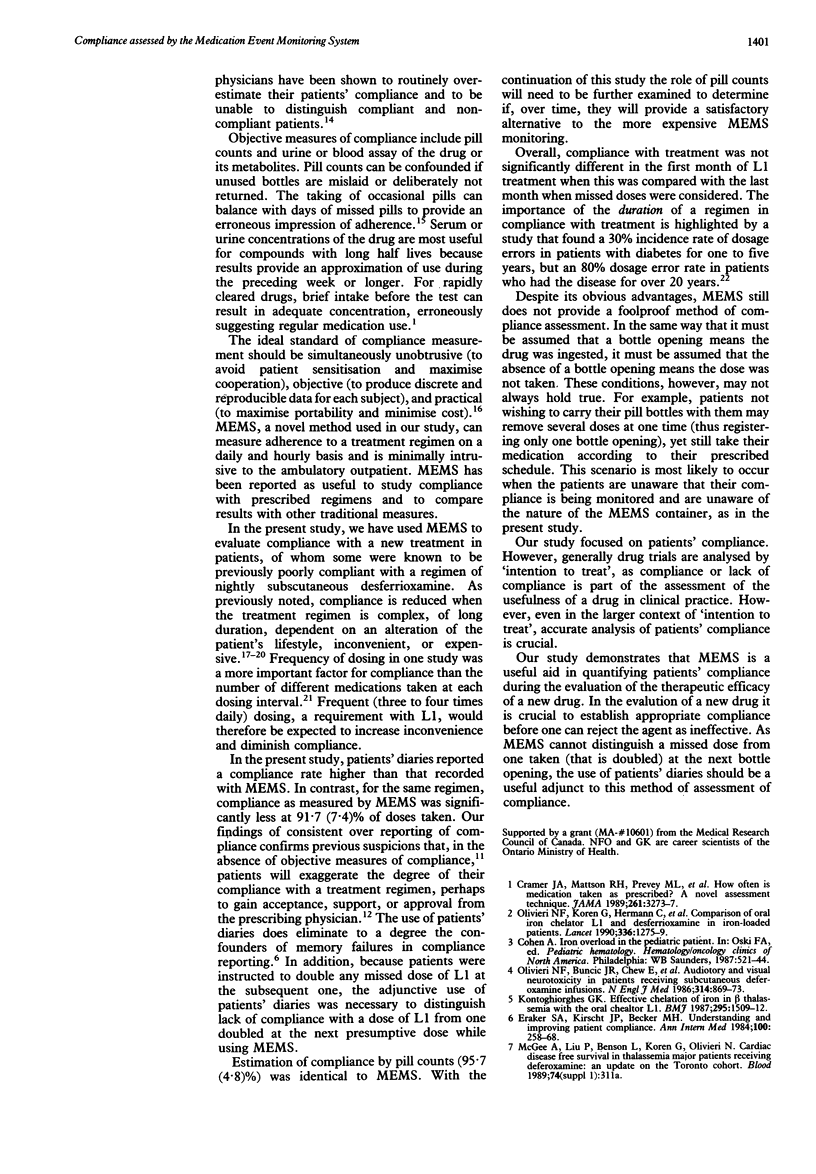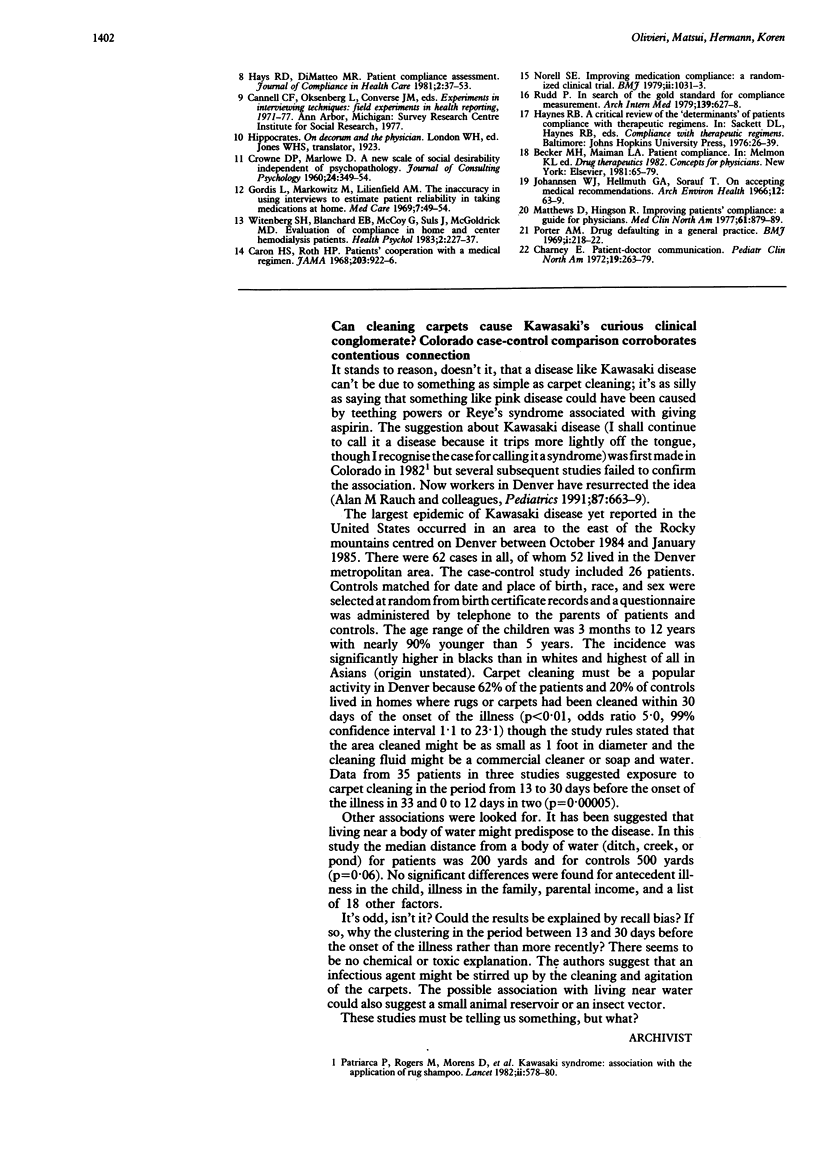Abstract
The accurate assessment of patient compliance is especially crucial in evaluating the efficacy of a new treatment. Because of the problems associated with parenteral desferrioxamine, the development of a safe, effective, and convenient iron chelator is of high priority. The high morbidity and mortality associated with iron overload requires careful evaluation of the ability of any new agent to promote long term effective iron chelation. Patients' compliance with an orally available chelating agent, 1,2,-dimethyl-3-hydroxypyrid-4-one (L1), that has been demonstrated to induce in vivo iron excretion equivalent to that of desferrioxamine during supervised short term administration, was examined. Compliance was assessed in seven patients by patient interview, by daily diaries reviewed monthly with each patient, and with the use of the Medication Event Monitoring System (MEMS) standard pill bottles with microprocessors in the cap that record the timing and frequency of bottle openings. L1 was dispensed in MEMS containers to the patients, who, unaware of their significance, recorded compliance using a daily diary. Overall compliance rate (% of prescribed doses taken) measured by MEMS was 88.7 +/- 6.8%. When 'doubling of doses' was accounted for, significantly poorer compliance with L1 was noted by MEMS (91.7 +/- 7.4%) than by patients' diaries (95.7 +/- 5.2%). There was no significant difference in patient compliance recorded between the first and last 30 day period of drug administration. MEMS can eliminate the confounding variable of erratic patient compliance in the evaluation of a new drug's efficacy. As MEMS cannot distinguish a missed dose from one doubled at the next bottle opening, the use of patient diaries is a useful adjunct to the accurate assessment of compliance and should be combined with the use of MEMS.
Full text
PDF



Selected References
These references are in PubMed. This may not be the complete list of references from this article.
- CROWNE D. P., MARLOWE D. A new scale of social desirability independent of psychopathology. J Consult Psychol. 1960 Aug;24:349–354. doi: 10.1037/h0047358. [DOI] [PubMed] [Google Scholar]
- Caron H. S., Roth H. P. Patients' cooperation with a medical regimen. Difficulties in identifying the noncooperator. JAMA. 1968 Mar 11;203(11):922–926. [PubMed] [Google Scholar]
- Charney E. Patient-doctor communication. Implications for the clinician. Pediatr Clin North Am. 1972 May;19(2):263–279. doi: 10.1016/s0031-3955(16)32699-2. [DOI] [PubMed] [Google Scholar]
- Cramer J. A., Mattson R. H., Prevey M. L., Scheyer R. D., Ouellette V. L. How often is medication taken as prescribed? A novel assessment technique. JAMA. 1989 Jun 9;261(22):3273–3277. [PubMed] [Google Scholar]
- Eraker S. A., Kirscht J. P., Becker M. H. Understanding and improving patient compliance. Ann Intern Med. 1984 Feb;100(2):258–268. doi: 10.7326/0003-4819-100-2-258. [DOI] [PubMed] [Google Scholar]
- Gordis L., Markowitz M., Lilienfeld A. M. The inaccuracy in using interviews to estimate patient reliability in taking medications at home. Med Care. 1969 Jan-Feb;7(1):49–54. doi: 10.1097/00005650-196901000-00006. [DOI] [PubMed] [Google Scholar]
- Johannsen W. J., Hellmuth G. A., Sorauf T. On accepting medical recommendations. Experiences with patients in a cardiac work classification unit. Arch Environ Health. 1966 Jan;12(1):63–69. doi: 10.1080/00039896.1966.10664337. [DOI] [PubMed] [Google Scholar]
- Kontoghiorghes G. J., Aldouri M. A., Hoffbrand A. V., Barr J., Wonke B., Kourouclaris T., Sheppard L. Effective chelation of iron in beta thalassaemia with the oral chelator 1,2-dimethyl-3-hydroxypyrid-4-one. Br Med J (Clin Res Ed) 1987 Dec 12;295(6612):1509–1512. doi: 10.1136/bmj.295.6612.1509. [DOI] [PMC free article] [PubMed] [Google Scholar]
- Matthews D., Hingson R. Improving patient compliance: a guide for physicians. Med Clin North Am. 1977 Jul;61(4):879–889. doi: 10.1016/s0025-7125(16)31304-9. [DOI] [PubMed] [Google Scholar]
- Norell S. E. Improving medication compliance: a randomised clinical trial. Br Med J. 1979 Oct 27;2(6197):1031–1033. doi: 10.1136/bmj.2.6197.1031. [DOI] [PMC free article] [PubMed] [Google Scholar]
- Olivieri N. F., Buncic J. R., Chew E., Gallant T., Harrison R. V., Keenan N., Logan W., Mitchell D., Ricci G., Skarf B. Visual and auditory neurotoxicity in patients receiving subcutaneous deferoxamine infusions. N Engl J Med. 1986 Apr 3;314(14):869–873. doi: 10.1056/NEJM198604033141402. [DOI] [PubMed] [Google Scholar]
- Olivieri N. F., Koren G., Hermann C., Bentur Y., Chung D., Klein J., St Louis P., Freedman M. H., McClelland R. A., Templeton D. M. Comparison of oral iron chelator L1 and desferrioxamine in iron-loaded patients. Lancet. 1990 Nov 24;336(8726):1275–1279. doi: 10.1016/0140-6736(90)92962-h. [DOI] [PubMed] [Google Scholar]
- Patriarca P. A., Rogers M. F., Morens D. M., Schonberger L. B., Kaminski R. M., Burns J. C., Glode M. P. Kawasaki syndrome: association with the application of rug shampoo. Lancet. 1982 Sep 11;2(8298):578–580. doi: 10.1016/s0140-6736(82)90660-2. [DOI] [PubMed] [Google Scholar]
- Porter A. M. Drug defaulting in a general practice. Br Med J. 1969 Jan 25;1(5638):218–222. doi: 10.1136/bmj.1.5638.218. [DOI] [PMC free article] [PubMed] [Google Scholar]
- Rauch A. M., Glode M. P., Wiggins J. W., Jr, Rodriguez J. G., Hopkins R. S., Hurwitz E. S., Schonberger L. B. Outbreak of Kawasaki syndrome in Denver, Colorado: association with rug and carpet cleaning. Pediatrics. 1991 May;87(5):663–669. [PubMed] [Google Scholar]
- Rudd P. In search of the gold standard for compliance measurement. Arch Intern Med. 1979 Jun;139(6):627–628. [PubMed] [Google Scholar]


